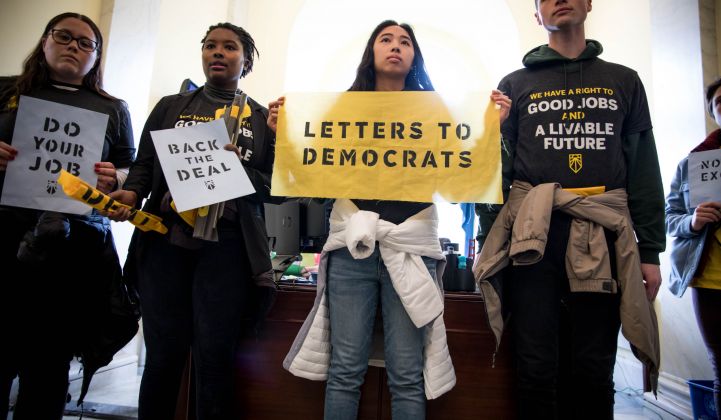Democratic members of the U.S. House of Representatives Select Committee on the Climate Crisis on Tuesday unveiled a mammoth and wide-ranging policy plan to embed climate action and resilience within the country’s economy.
The report — which sought to put racial and environmental justice at the center of its recommendations — laid out policies to help the U.S. work toward net-zero greenhouse gas emissions in all areas of the nation’s economy by midcentury, reaching net negative emissions beyond that. An analysis of the plan’s impacts from think tank Energy Innovation quantified its health and climate benefits at nearly $8 trillion by 2050 in 2018 dollars.
Due to Republican control of the White House and the Senate, the plan is extremely unlikely to gain traction in Congress, especially as the 2020 election approaches. But the policy priorities it contains, laid out over more than 500 pages, demonstrate a marked shift in congressional dialogue and focus around climate change. The House created the Select Committee in January of last year to craft policy recommendations on climate change after widespread protests for climate action and calls for a Green New Deal.
“It shows that the committee has been listening to stakeholders and has watched the Democratic primary carefully,” Leah Stokes, a political science professor at the University of California, Santa Barbara who recently published a book on U.S. clean energy and climate policy, told The Guardian.
Democratic presidential nominee Joe Biden has outlined a goal to reach net-zero emissions by 2050 and has endorsed the Green New Deal as a “framework” for climate action. He does not appear to have commented directly on the plan from House Democrats.
Numerous clean-energy recommendations
If adopted, the recommendations would have significant ramifications for the clean energy industry. Not only does the plan call for the development of new tax credits, incentives and innovation programs to support clean energy, but it also recommends tearing down current economic structures that benefit fossil fuels while not reflecting the costs of their associated pollution.
Lawmakers write that “decarbonization of the electricity sector is the linchpin of any national strategy to achieve net-zero emissions.” Under the plan, the U.S. would reach net-zero emissions from power generation by 2040.
To boost U.S. clean energy deployment and delivery, the plan directs the Federal Energy Regulatory Commission to develop long-range transmission strategy and reduce barriers to clean energy participation in power markets. The agency is currently embroiled in a battle over requirements that renewables receiving state subsidies must bid into grid operator PJM’s capacity market at high prices that make those resources uncompetitive.
The committee also recommended Congress extend and expand renewables tax credits, in particular adding a credit for grid-scale storage while also investing in research and development for that technology. Lawmakers would also like to see a production tax credit for clean-energy technologies and products in order to boost U.S. manufacturing in the space.
Under the committee’s plan, the Department of Energy would also be reorganized to prioritize climate and would add an Energy Justice and Democracy Program to widen access to renewables and energy efficiency in marginalized communities.
The federal government would harden grid infrastructure, develop federal resilience standards for the electricity grid, and offer incentives to communities for the installation of distributed energy resources.
Clean energy would also play a role in decarbonizing buildings, transportation and heavy-duty industry.
In the end, the writers of the plan recognize the last mile of decarbonization will be in the hardest-to-electrify sectors, such as heavy-duty trucking and manufacturing. Energy Innovation’s analysis showed the recommendations would slash U.S. greenhouse gas emissions 88 percent from 2010 levels by 2050.
To achieve further emissions reductions, the report encourages development of carbon-removal technologies, a controversial tool also included in the October 2018 Intergovernmental Panel on Climate Change report that outlined the significant global changes needed for the world to remain under 1.5 degrees Celsius of warming. Notably, the House committee also included the potential for carbon-free nuclear power in its plan but called for a thorough assessment of the technology’s costs and potential risks.
While the Democratic plan gained plaudits from clean-energy trade organizations including the American Wind Energy Association, the American Council on Renewable Energy and the Solar Energy Industries Association, praise was more subdued from the environmental organizations that have been the most vocal supporters of the Green New Deal.
“This plan is more ambitious than anything we have seen from Democratic leadership so far, but it still needs to go further to match the full scale of the crisis,” said Lauren Maunus, legislative manager for the Sunrise Movement, a grassroots group that helped draft the Green New Deal resolution.
A statement from 350.org encouraged stronger targets for emissions cuts including timelines for ending fossil fuel production and subsidies for oil, gas and coal.
The committee's roadmap would need to be translated into legislation to further its impact. Separate from the plan, House Democrats recently introduced extensions of the existing federal Production Tax Credit and Investment Tax Credit as part of a large infrastructure package, which the White House has already threatened to veto due to its environmental provisions.




